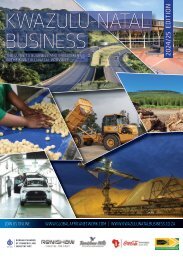Limpopo Business 2016-17 edition
The 2016/17 edition of Limpopo Business is the eighth issue of this highly successful publication that, since its launch in 2007, has established itself as the premier business and investment guide to the Limpopo province. Limpopo is unique in terms of its abundant natural and human resources, and is also one of the key drivers behind the South African economy. This edition of Limpopo Business is officially endorsed by the Office of the Premier of Limpopo.
The 2016/17 edition of Limpopo Business is the eighth issue of this highly successful publication that, since its launch in 2007, has established itself as the premier business and investment guide to the Limpopo province.
Limpopo is unique in terms of its abundant natural and human resources, and is also one of the key drivers behind the South African economy.
This edition of Limpopo Business is officially endorsed by the Office of the Premier of Limpopo.
Create successful ePaper yourself
Turn your PDF publications into a flip-book with our unique Google optimized e-Paper software.
OVERVIEW<br />
Mining<br />
The Waterberg region is attracting mining companies.<br />
SECTOR INSIGHT<br />
After several years of rising prices and increasing demand,<br />
the global commodities market experienced lower prices<br />
and shrinking demand in 2015. This had a lot to do with<br />
slower growth in China, but South African mining companies<br />
also had to deal with rising energy prices, labour upheavals and<br />
legislative uncertainty.<br />
There have consequently been some big changes to the mining<br />
landscape, and not just in South Africa. One of the most significant is<br />
the change of focus by Anglo American, one of the world’s biggest<br />
resource companies. It decided to focus sharply on diamonds, copper<br />
and platinum. This is not just in the company’s South African mines, but<br />
rather a global decision which will affect Anglo’s operations in North<br />
and South America, Australia and South Africa. In 2015 the Anglo group<br />
had 55 mines, employed 128 000 people and had revenue of $23-billion.<br />
The sale of Anglo’s iron-ore and coal assets has provided an opportunity<br />
for other mining companies that want to mine differently or<br />
acquire new assets.<br />
Sibanye Gold, going beyond the name it acquired when Goldfields<br />
was unbundled in 2013, bought platinum mines in Rustenburg<br />
Chinese companies have<br />
been very active in the<br />
<strong>Limpopo</strong> mining sector.<br />
• Sibanye Gold is buying<br />
platinum assets.<br />
• Hebei Iron and Steel and<br />
the IDC may build a steel<br />
mill in <strong>Limpopo</strong>.<br />
• A provincial mining roundtable<br />
was held to promote<br />
industrialisation.<br />
• A national Energy<br />
Metallurgical Base Project<br />
will anchor the planned<br />
Special Economic Zone at<br />
Musina.<br />
• Phalaborwa Copper will<br />
spend R9.3-billion on<br />
extending the life of the<br />
mine.<br />
• Anglo American is selling<br />
some assets, but investing<br />
more money in diamond<br />
mining in <strong>Limpopo</strong>.<br />
• Exxaro is investigating<br />
Underground Coal<br />
Gasification.<br />
from Anglo American Platinum<br />
(Amplats) in 2015 and has expressed<br />
interest buying coal assets,<br />
mostly to offset rising energy<br />
costs at its own mines.<br />
Anglo’s 16.8% share in the<br />
copper mine, smelter and<br />
refinery in Phalaborwa was dis-<br />
LIMPOPO BUSINESS <strong>2016</strong>/<strong>17</strong><br />
50


















